



Neck & Upper Back Pain
Stretching, Strength and Endurance Training
Why It's Important
Sitting at a desk in the same position for an extended period of time, puts a lot of pressure on the neck, shoulders, and upper back leading to pain and in turn making simple daily activities painful (Sihawong, Janwantanakul, & Jiamjarasrangsi, 2014). Strength and endurance training is important in helping to prevent and alleviate the tension and pain caused by prolonged deskwork, and restore muscle power. This neck and shoulder exercise program consists of a combination of three components: stretching, strength and endurance, and aerobic conditioning.
The following exercises were taken from a variety of resources designed by different professionals.
Stretching Execises
People who sit at a desk for a prolonged period on their computer often have their head and shoulders drift forward causing the muscles to shorten and become tight. Stretching exercises can improve or sustain the range of motion and elasticity in the affected joints, relieving the stiffness that leads to pain but also preventing the muscles from becoming tight in the first place (Morrison, 2011). Ideally, stretching exercises should be performed daily with certain stretches done several times a day.
3-Way Neck Stretch
These stretches focus directly on relieving neck pain, targeting the front, back, and sides of the neck. These can be performed either sitting or standing, and hold each stretch for 30–60 seconds.
-
Simply lean your head as far as you can to one side as if attempting to bring your ear to your shoulder. Gently, you can use your hand to pull your ear toward your shoulder and have your opposing hand at a right angle behind your back to deepen the stretch. Switch sides.
-
Slowly turn your head to one side and then look down towards that shoulder as if attempting to bring nose to shoulder. Gently, you can use your hand to pull your head down toward the shoulder with the opposing hand at a right angle behind your back to deepen the stretch. Switch sides.
-
Bend your neck toward one side, as if attempting to drop one ear toward the shoulder, and then tilt the head back slightly to look up. Gently, you can use your hand to pull your ear toward your shoulder and have your opposing hand at a right angle behind your back to deepen the stretch. Switch sides.



1
2
3
Shoulder Rolls
To relieve tension in the shoulders, roll shoulders back and down in slow circles. Can be done sitting or standing. Perform at least 10 shoulder rolls.
Neck-Shoulder-Chest Stretch
To stretch your shoulders, neck and chest; hold your hands together from the back by interlocking the fingers. Slowly lift your hands up towards the ceiling until you feel a slight stretch in your chest and shoulders. Then bring your chin towards your chest. Hold the position for 30 seconds, and can be repeated 3 to 5 times a day. This can be done while sitting straight or standing.
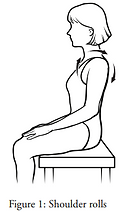

Neck-Shoulder-Chest
Corner Stretch
This exercise is important for stretching the chest and shoulder muscles. The chest muscles can pull the shoulders forward, which can add extra strain in the neck and back. This stretch can reduce the stress on the neck and back. It is done in a corner of a room, and can be repeated 3 to 5 times a day.
-
Facing the corner, stand approximately two feet back from the corner with your feet together.
-
Place your forearms on each wall, with the elbows raised a little below shoulder height (F1)
-
Lean forward as far as possible, feeling a stretch in your chest and shoulders but without pain (F2)
-
Hold stretch for 30 to 60 seconds

F1

F2
Strength and Endurance Training
Strengthening exercises helps maintain good posture, which will result in eliminating or lessening recurrent neck, shoulder and upper back pain. Ideally, strengthening exercises should be done every other day to allow the muscles to rest and recover.
Chin Tuck
The chin tuck is a great exercise to help fight against neck pain as it strengthens the muscles that pull the head back into alignment over the shoulders. It also builds endurance, and helps to maintain or improve flexibility. This exercise can be performed multiple times throughout the day, such as when you are sitting at a desk working. The chin tuck can be done either standing or sitting.
Standing
-
Stand about 3 inches away from the wall (F3)
-
Tuck your chin straight back and pull your head back and hold it against the wall for 5 seconds (F4)
-
Repeat 10 times
-
This can be performed 5 to 10 times throughout the day
Sitting
-
Sit up straight, focusing on an object at eye level
-
Slowly without moving your shoulder, and without looking up or down, bring your head back and tuck your chin in and hold for 5 seconds
-
Repeat 10 times
-
This can be performed 5 to 10 times throughout the day

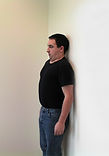
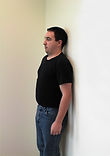
F3
F4
Standing
Sitting
Prone Cobra
The prone cobra exercise strengthens the muscles of the shoulder girdle, and the neck and upper back area. This exercise is done laying face down on the floor with gravity as resistance for strengthening.
Performing the exercise:
-
Lay face down on the floor, and use a rolled up hand towel to support forehead
-
Arms on the side with palms facing downward (F5)
-
Have your tongue touching the roof of your mouth. This will help stabilize the muscles in front of your neck to assist in strengthening
-
Bring your shoulder blades together and lift your hands off the floor
-
Roll your elbows in having the palms out and thumbs up (F6)
-
Gently lift your forehead about one inch off the towel, continuing to look at the floor (F7)
-
Hold for 10 seconds and repeat 10 times

F5
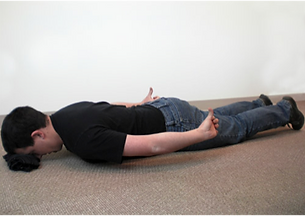
F6
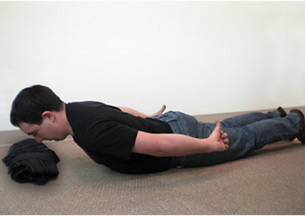
F7
Strength and Endurance Training Using Dumbbells
To build overall strength and endurance instead of muscle size, exercises will be performed with low weight and high repetitions. Before moving on to strengthening exercises, you must first warm up and stretch your neck and upper back muscles. Ideally, training regimen should be performed three sessions a week. Each session consist of three sets of three of the exercises listed below with 2 or 3 pounds dumbbells and 12 to 20 repetitions. When first starting the routine, you may not be able to do 12, but just do as many as you can and increase the repetitions as you get stronger to build even more endurance.
Shoulder Shrug
This exercise will help keep shoulders from hanging downward, it works on the trapezius, levator scapulae, and the rhomboids.
Performing the exercise:
-
Stand straight with feet shoulder width apart
-
Hold a pair of dumbbells at you side with palms facing in
-
Shrug you shoulders up towards your ears and slightly back bringing your shoulder blades closer together
-
Slowly lower you shoulder back to starting point
-
Repeat

Bent-Over Row
A back exercise that work on the rhomboids, important for posture.
Performing the exercise:
-
Grasp the dumbbell with your left hand
-
Stand at the left side of a knee-high workout bench and place your right knee on the bench, bending at the waist and having your palm on the front of the bench for balance
-
Make sure you left arm is straight, palm facing in and weight hanging toward the ground
-
Slowly pull up the weight straight up toward your chest, then gently lower and repeat
-
Switch sides and repeat the exercise with the right arm
Upright Row
This exercise targets the upper, middle, and lower trapezius.
Performing the exercise:
-
Stand straight with feet shoulder width apart
-
Grasp the dumbbells directly in front of your thighs with palms facing your body
-
Keeping the weights close to your body and neck straight, slowly lift the dumbbells up to your chest by bending at the elbows
-
Gently lower the dumbbells and repeat
Shoulder Abduction
This exercise targets the deltoid muscle.
Performing the exercise:
-
Stand straight with feet shoulder width apart
-
Hold a pair of dumbbells at you side, pressed against your thighs
-
Having the elbow slightly bend, extend the dumbbells out to your sides until arms are parallel to the floor with the palms facing down
-
Slowly lower and bring back to starting point
-
Repeat
Aerobic Conditioning



To increase blood flow within the neck and upper back muscles, individuals can perform aerobic exercises to help with loosening the muscles and increasing range of motion (Morrison, 2011). Moreover, after 30 to 40 minutes of aerobic exercise, our body produces endorphins, which are natural painkillers that can help reduce neck pain (Morrison, 2011). Aerobic conditioning can be performed everyday and can include a session on the treadmill, stationary bike or an elliptical machine.
More Information
For more information, visit the Spine-health website, a resource providing information on back and neck pain. The website features new and useful information on a variety of conditions, treatment and wellness, it has animations, videos, forums, a blog, and contact information for finding a health specialists.
This video, designed by a group of Physiotherapist, has even more neck and upper back exercises that can help alleviate pain.
References
Andersen, L. L., Andersen, J. L., Suetta, C., Kjaer, M., Sogaard, K., & Sjogaard, G. (2009). Effect of contrasting physical exercise interventions on rapid force capacity of chronically painful muscles. Journal of Applied Physiology, 107, 1413–1419.
Barraclough, M. (2013). Best neck and upper back exercises for women. Retrieved from http://www.askthetrainer.com/upper-back-exercises-for-women/
Morrison, G. (2011). Neck exercises for neck pain. Retrieved from http://www.spine-health.com/conditions/neck-pain/neck-exercises-neck-pain
Segars, D., & Segars, K. (2012). Shoulder and neck exercises and stretches. Retrieved from https://www.fitnessblender.com/videos/shoulder-and-neck-exercises-and-stretches
Sihawong, R., Janwantanakul, P., & Jiamjarasrangsi, W. (2014). Effects of an exercise programme on preventing neck pain among office workers: A 12-month cluster-randomised controlled trial. Occupational and Environmental Medicine, 71, 63–70.
